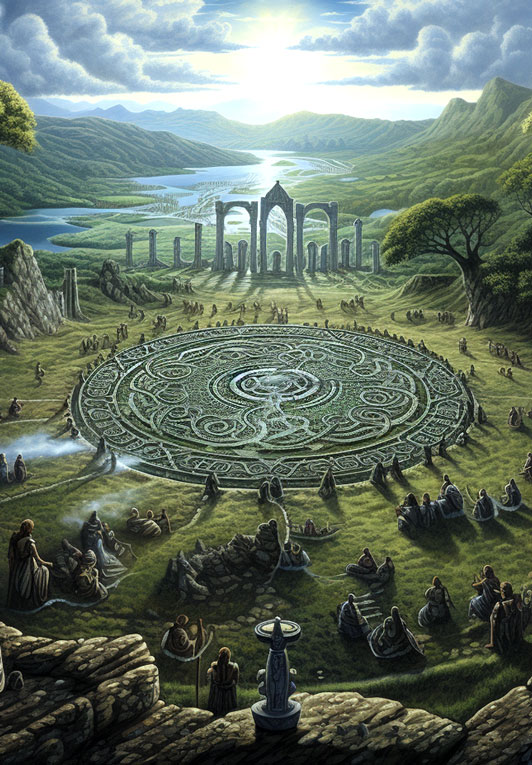Tirvox ad Coimi - Stone Crown
On our way to the stone circles of Aslae, our path took us through the middle of Stone Crown. We were on the large east road of Âdocôris and from afar we could see the high wall of the city, sandwiched between two sandstone cliffs. It was the middle of the day and the gates of Stone Crown were wide open to let pilgrims, traveling traders and travelers through. The entire town, whose houses were spread over several hills, was filled with the hustle and bustle of residents and visitors.Druid in transit -
At a glance
Name: Stone Crown, Crown of Stones
Size: 365 km²
Quarters: 5 - Palace & Nobility, Army, Scholars, Trade & Crafts, Citizens' Quarter
Government: 3 Grandmasters of the guilds by election every four years with accountability to the Prince's City Chancellor
Sights: Museum of Goblin History, Gallery of Arts, Library, Equestrian Monument, Crown Garden
Important buildings: Crown Palace Palace , University, Council House, Druid Circle, Hospital, Trade Guild, Bank of Âdocôris, Guilds, Port
Population: 174,610
Inhabitants: Tirvoxica
Demographics : 2% Nobility, 3% Shamans, 3% Druids, 5% Foreigners, 10% Warriors, 12% Trade, 15% Artisans, 50% Commoners
Position
City history
From its founding to the first battles with neighboring countries
- 5,800 BEC The first settlers cross the valley and settle on the banks of the Linth.
- 5,750 BEC First documented mention as Tirwogs a Goimee
- 5,500 BEC In Aslae, primordial druids discover larger earth energies and build small stone circles.
- 4,900 BEC Circle of Druids opens a branch in the city.
- 4,000 BEC Guilds and circles settle in the city, trade and crafts flourish.
- 3,586 BEC 1st Battle of Aslae against western Vadriv
- 3,343 BEC 2nd Battle of Aslae against northern Dan Wudir
The rise to the capital of Âdocôris
- 2,750 BEC The Great Flood reaches the city via sea level rise from the north and via the Swidru and the Oininhi ad Îdrucoi and breaks through the simple pallisade walls
- 1,000 BEC Expansion of the city up to the rock walls and construction of the city walls.
- 983 BEC After the 3rd Brictaelgian War and the Treaty of Laentas, Tamid the Great declares Stone Crown the capital of Âdocôris
- 26 BEC Major fire destroys the northwest part of the city
The expansion under the royal house of Mushroomy Western Meadows
- 500 AEC Creation of the royal house of Mushroomy Western Meadows
- 929 AEC Vinduk I, Great King of Âdocôris, founded the great university of Tirvox ad Coimi
- 1,112 AEC Crown peace after the war against Taen Wortris for supremacy in Brictaelgis
- 2,477 AEC Inauguration of the Crown Palace of Tirvox ad Coimi
Government
- Finance, Commerce & Legal System
- Healing beings & theory of elements
- Construction, Engineering & Infrastructure
Life in the city
We walked to the Linth, which flowed through the city south of the east gate. Drays rumbled over the cobblestones, pushing past the travelers and merchants on the great main street. So we turned into a side street and crossed the river over one of the small, curved wooden bridges.Many houses were multi-story and although hardly any house was similar to the other, they fit together harmoniously. The facades were decorated with flowers and small bushes. Most of the roofs had mossy caps with a few daisies and mushrooms peeking out. It was much quieter away from the main road, so we sat on a bench under one of the large trees and lingered.Druid in transit -
Infrastructure & Defense
Architecture
The quarters
Aa long rest, we strolled from the druid circle to the market, the beating heart of this city, which offered everything we needed for our journey. Our path then took us past the palace of the princely family, which was driven into the rock of the south wall over a hundred years ago and now rose majestically above the city. We reached the princely garden via a few stairs, which allowed all visitors entry. From here we let our gaze wander again over the entire city towards the north wall before we continued our journey through the west gate.Druid in transit -

























Awesome! \o/ I like it.
Thank you, I really appreciate it ;).